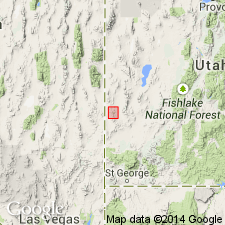
- Usage in publication:
-
- Mackleprang Tuff Member*
- Modifications:
-
- Named
- Reference
- Dominant lithology:
-
- Tuff
- AAPG geologic province:
-
- Great Basin province
Summary:
Named as a middle member of Ryan Spring Formation of Needles Range Group for Mackleprang Homestead 3 km due east of Ryan Spring, Beaver Co, UT, Great Basin province. Type section designated in NW1/4 sec 36, T28S, R19W. Is a simple cooling unit. Composed of crystal-poor, lithic-rich rhyolite ash-flow tuff. Distinguished from underlying Greens Canyon Member by its larger and slightly more abundant phenocrysts of plagioclase and biotite, and by more strongly developed compaction foliation defined by varicolored, flattened pumice lapilli. Locally includes well-sorted sandstone above and below the tuff. Reference section designated in secs 34 and 35, T28S, R18W, where member is thicker and variably welded. Locally includes well-sorted sandstone above the tuff. Was derived from Indian Peak caldera. Covered an area of 400 sq km. Had a volume of 100 cubic km. Areal extent shown on figure. Wedges out south of Sawtooth Peak. Thickens and thins. Reappears south of Indian Peak. Thickens to several hundred m south of Arrowhead Pass. Underlies Lund Formation. Is of Oligocene age. Stratigraphic chart.
Source: GNU records (USGS DDS-6; Denver GNULEX).
For more information, please contact Nancy Stamm, Geologic Names Committee Secretary.
Asterisk (*) indicates published by U.S. Geological Survey authors.
"No current usage" (†) implies that a name has been abandoned or has fallen into disuse. Former usage and, if known, replacement name given in parentheses ( ).
Slash (/) indicates name conflicts with nomenclatural guidelines (CSN, 1933; ACSN, 1961, 1970; NACSN, 1983, 2005, 2021). May be explained within brackets ([ ]).

